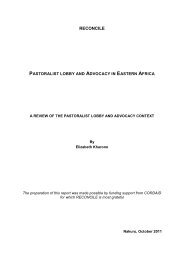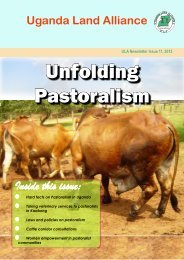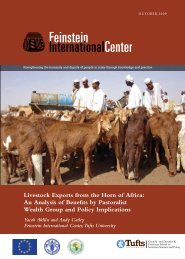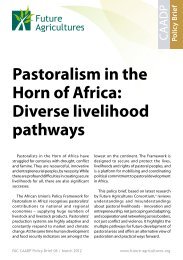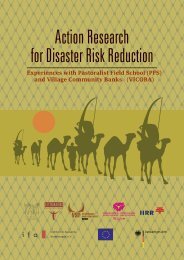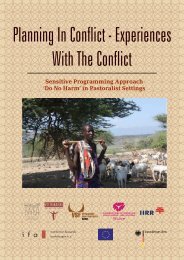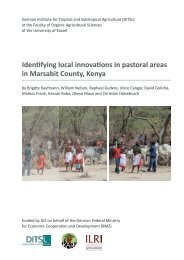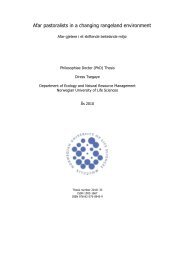Boran pastoral women - celep
Boran pastoral women - celep
Boran pastoral women - celep
You also want an ePaper? Increase the reach of your titles
YUMPU automatically turns print PDFs into web optimized ePapers that Google loves.
REPORTS<br />
ethnically homogenous communities so as to<br />
avoid costs resulting from heterogeneity (15),<br />
and that heterogeneity of preferences among<br />
groups can promote lower contributions toward<br />
public goods on the level of entire countries (16).<br />
In addition, differences in returns to public goods<br />
can determine the interaction between ethnic<br />
diversity and the collective action necessary in<br />
order to bring about economic cooperation (17).<br />
Our experimental findings thus replicate<br />
previous findings on the importance of the ability<br />
to sanction as a strong determinant of levels<br />
of public goods contribution. Our results enhance<br />
these previous findings by highlighting the need<br />
to focus on institutional contexts and by underlining<br />
the way that institutions condition both<br />
the role of ethnic diversity and the role of sanctions<br />
in public goods contribution. Although in<br />
the real world diversity is often associated with<br />
the danger of conflict, making economic and<br />
social cooperation difficult to achieve, our work<br />
suggests that institutions may play an important<br />
role in creating environments in which diversity<br />
can be bridged and sanctions can be implemented<br />
in order to promote well-ordered societies and<br />
better-functioning markets.<br />
References and Notes<br />
1. R. Axelrod, W. D. Hamilton, Science 211, 1390 (1981).<br />
2. E. Fehr, U. Fischbacher, S. Gätcher, Hum. Nat. 13,<br />
1 (2002).<br />
3. E. Fehr, U. Fischbacher, Nature 425, 785 (2003).<br />
4.D.J.-F.deQuervainet al., Science 305, 1254<br />
(2004).<br />
5. E. Fehr, A. Falk, J. Polit. Econ. 107, 106 (1999).<br />
6. R. Trivers, Q. Rev. Biol. 46, 35 (1971).<br />
7. E.Fehr,U.Fischbacher,Trends Cogn. Sci. 8, 185<br />
(2004).<br />
8. S.Bowles,H.Gintis,J. Econ. Behav. Organ. 55,<br />
1 (2004).<br />
9. S. Bowles, H. Gintis, Theor. Popul. Biol. 65, 17 (2004).<br />
10. A. Alesina, E. L. Ferrara, J. Econ. Lit. 43, 762 (2005).<br />
11. B. Herrmann, C. Thöni, S. Gächter, Science 319, 1362<br />
(2008).<br />
12. J. Habyarimana, M. Humphreys, D. N. Posner, Jeremy<br />
Weinstein, Coethnicity: Diversity and the Dilemmas of<br />
Collective Action (Russell Sage Foundation, New York,<br />
2009).<br />
13. H. Bernhard, U. Fischbacher, E. Fehr, Nature 442, 912<br />
(2006).<br />
14. E.Miguel,M.K.Gugerty,J. Public Econ. 89, 2325<br />
(2005).<br />
15. A. Alesina, E. L. Ferrara, Q. J. Econ. 115, 847 (2000).<br />
16. A. Alesina, R. Baqir, W. Easterly, Q. J. Econ. 114, 1243<br />
(1999).<br />
17. R. Wade, Village Republics: Economic Conditions for<br />
Collective Action in South India (ICS, San Francisco, 1994).<br />
Acknowledgments: We acknowledge funding from the<br />
Russell Sage Foundation, Harvard Davis Center for Russian<br />
and Eurasian Studies, and the Harvard Weatherhead Center<br />
for International Affairs. The authors declare that they have<br />
no competing financial interests. Informed consent was<br />
obtained after the nature and possible consequences of the<br />
study were explained. We thank the editor and two<br />
anonymous referees for their consideration and excellent<br />
feedback. We also thank R. H. Bates, N. Christakis, E. Fehr,<br />
M. C. Harding, and G. King. We are grateful to the directors<br />
and students of the three participating high schools in the<br />
city of Mostar in Bosnia-Herzegovina. Our thanks go to<br />
C. Hazlett for outstanding research assistance and to<br />
D. Sekulić for advice in the field.<br />
Supporting Online Material<br />
www.sciencemag.org/cgi/content/full/334/6061/1392/DC1<br />
SOM Text<br />
Fig. S1<br />
Tables S1 to S5<br />
References and Notes<br />
7 January 2011; accepted 27 October 2011<br />
10.1126/science.1202599<br />
1394<br />
Capacity Building Helps Pastoral<br />
Women Transform Impoverished<br />
Communities in Ethiopia<br />
D. Layne Coppock, 1 * Solomon Desta, 2 Seyoum Tezera, 2 Getachew Gebru 2<br />
Poverty, drought, and hunger devastate people on Africa’s rangelands. We used an action-oriented<br />
approach from 2000 to 2004 to build capacity among thousands of <strong>pastoral</strong>ists to diversify livelihoods,<br />
improve living standards, and enhance livestock marketing. The process included collective action,<br />
microfinance, and participatory education. Poor <strong>women</strong> previously burdened by domestic chores<br />
became leaders and rapidly changed their communities. Drought occurred from 2005 to 2008. We<br />
assessed intervention effects on household drought resilience with a quasiexperimental format that<br />
incorporated survey-based comparisons of treatment groups with ex post controls. Interventions led to<br />
major improvements in trends for quality of life, wealth accumulation, hunger reduction, and risk<br />
management. Human capacity building can be a driver for change, generating hope and aspirations<br />
that set the stage for the use of new information and technology.<br />
Historically, African <strong>pastoral</strong> societies had<br />
low densities of people, large livestock<br />
herds, and access to vast grazing lands.<br />
This allowed for subsistence food production<br />
(e.g., milk and meat), accumulation of animal<br />
wealth, and sustainable use of natural resources.<br />
Unfortunately, this situation has changed (1, 2).<br />
Pastoralists today are often poverty stricken and<br />
beset by hunger. Efforts to “develop” <strong>pastoral</strong>ism<br />
have had little success (3–5). Human population<br />
growth, overgrazing, annexation of key resources<br />
1 Department of Environment and Society (EnvS), Utah State<br />
University, Logan, UT 84322–5215, USA. 2 Managing Risk for<br />
Improved Livelihoods (MARIL) PLC, Post Office Box 90112,<br />
Addis Ababa, Ethiopia.<br />
*To whom correspondence should be addressed. E-mail:<br />
layne.coppock@usu.edu<br />
9 DECEMBER 2011 VOL 334 SCIENCE www.sciencemag.org<br />
by outside entities, physical insecurity, and underinvestment<br />
in <strong>pastoral</strong> areas contribute to declining<br />
per capita food production, reduced vegetation<br />
cover, increased soil erosion, loss of herd mobility,<br />
and more marginalized people. Multiyear<br />
droughts pose grave threats to <strong>pastoral</strong>ists because<br />
crop failures and massive death losses of<br />
animals escalate into crises for food availability,<br />
income generation, and asset preservation.<br />
Technical options to increase food production<br />
or lessen pressure on natural resources remain<br />
elusive, largely because of environmental and<br />
social constraints. Alternatively, nontechnical options<br />
focused on human capacity building could<br />
have positive effects through livelihood diversification<br />
that improve risk management (2). Diversification<br />
could emphasize more involvement<br />
in commercial livestock production and nonlivestock<br />
microenterprises to balance traditional<br />
livestock production. This could help communities<br />
become more resilient when coping with<br />
drought (6).<br />
Once considered a prime example of sustainable<br />
<strong>pastoral</strong>ism in eastern Africa, the <strong>Boran</strong>a<br />
<strong>pastoral</strong> system of semiarid southern Ethiopia<br />
(Fig. 1) exemplifies the changes noted above. The<br />
people have become poorer and more vulnerable<br />
due to population growth and lack of development<br />
investment, a trend exacerbated by impacts from<br />
multiyear droughts in 1983–1985, 1991–1993,<br />
1998–1999, and 2005–2008. Each drought<br />
resulted in the deaths of about half of all livestock,<br />
losses having a cumulative value in the<br />
hundreds of millions of U.S. dollars (7). More<br />
details concerning the people and system dynamics<br />
are given in (8) (study area). The main objective<br />
of this research was to determine whether<br />
<strong>pastoral</strong> livelihoods on the <strong>Boran</strong>a Plateau could<br />
indeed be diversified in a sustainable fashion<br />
to lessen or reverse the downward spiral at the<br />
household level.<br />
Starting in 2000, we used an action-oriented,<br />
participatory approach to engage the <strong>pastoral</strong><br />
community to refine problem diagnosis, chart<br />
pathways for change, and identify and implement<br />
interventions. This integrated the ideas, skills, and<br />
resources of numerous partners (i.e., <strong>pastoral</strong>ists,<br />
researchers, development practitioners, educators,<br />
and donors). The process is described in (8) (treatment<br />
background). In short, the acute need for<br />
livelihood diversification was confirmed, a problem<br />
that required capacity building. Stepwise<br />
capacity-building interventions were undertaken<br />
(Fig. 2), including: (i) inspiring the Ethiopians<br />
to improve their circumstances by exposure to<br />
problem-solving methods and linking them to<br />
forward-thinking, successful peers in northern<br />
EMBARGOED UNTIL 2PM U.S. EASTERN TIME ON THE THURSDAY BEFORE THIS DATE:
Kenya; (ii) establishing collective-action groups<br />
to consolidate community leadership and create<br />
new social safety nets; (iii) improving literacy<br />
and numeracy through nonformal (participatory)<br />
education so that rudimentary banking and bookkeeping<br />
procedures could be adopted; (iv) promoting<br />
a savings culture and a means of managing<br />
financial resources through microfinance; (v)<br />
instilling best practices in the creation and management<br />
of small businesses through microenterprise<br />
training; and (vi) helping generate<br />
financial capital by connecting collective-action<br />
groups to expanding livestock markets.<br />
By 2004, this process had resulted in the<br />
creation of 59 collective-action groups on the<br />
<strong>Boran</strong>a Plateau with a total membership of 2300.<br />
Capacity building for individuals took 3 years<br />
on average. Women made up 76% of the founding<br />
members of collective-action groups, and they<br />
quickly assumed leadership positions. This was<br />
surprising given the subservient domestic roles<br />
that <strong>women</strong> traditionally occupy in this society<br />
[(8), study area].<br />
Although the collective-action groups were<br />
governed by illiterate <strong>women</strong> with scant previous<br />
leadership or business experience, members saved<br />
money and successfully managed thousands of<br />
microloans. Groups also supplied thousands of<br />
livestock to export markets [(8), treatment<br />
background]. Eleven of the stronger groups each<br />
received grants (US $3270) from a donor to help<br />
capitalize livestock trade. Members of groups<br />
receiving trading grants sold more animals than<br />
Greater Horn of Africa<br />
did members of groups not receiving grants [(8),<br />
treatment background].<br />
As the project matured, a major drought occurred<br />
during 2005–2008 resulting in the deaths<br />
of 40 to 60% of all livestock, heightening stress<br />
on the society. This situation gave us an opportunity<br />
to assess effects of the capacity-building<br />
package on livelihoods, well-being, and coping<br />
abilities of project participants during a crisis<br />
using a quasi-experimental approach. We implemented<br />
a survey in 2008 among 180 randomly<br />
selected residents in the Liben and Moyale Districts<br />
[(8), sampling and target population] (Fig. 1).<br />
Sixty respondents (30 per site) came from each of<br />
three treatment levels: capacity building (including<br />
all aspects of Fig. 2), capacity building plus<br />
the trading grant (henceforth referred to as CBG),<br />
and traditional peers (henceforth referred to as<br />
controls). The controls lived in the same areas as<br />
the others but had not been involved with the<br />
project [(8), treatment background and supporting<br />
online text].<br />
It was hypothesized that capacity building<br />
would fundamentally alter the well-being of<br />
people through diversified livelihoods, increased<br />
incomes, and reduced hunger (because of an<br />
increased ability to purchase food) relative to the<br />
controls. Adding trading grants would give further<br />
advantage to CBG members by playing a<br />
catalytic role in boosting livestock marketing,<br />
generating more income, and reducing hunger<br />
to a greater degree. Sites were not expected to<br />
influence treatment effects. Liben and Moyale<br />
Legend<br />
Asphalt Road<br />
Zonal Boundary<br />
District Boundary<br />
<strong>Boran</strong>a Zone<br />
Guji Zone<br />
Town<br />
Capital<br />
REPORTS<br />
were chosen because they had all three treatment<br />
levels present.<br />
Data collection involved asking respondents<br />
to identify trends (i.e., improving, no change, or<br />
declining) for 18 personal, household, community,<br />
and agricultural attributes and providing categorical<br />
answers to questions concerning change<br />
in wealth status, incidence of hunger, use of income,<br />
and future livelihood strategies. The time<br />
frame for trend analysis covered the previous<br />
three drought years. Two statistical approaches<br />
assessed treatment effects, logit models for ordinal<br />
responses, and chi square for homogeneity<br />
of proportions [(8), survey design and statistics].<br />
The prediction for ordinal responses was when<br />
the odds were compared of reporting improved<br />
circumstances among respondents from various<br />
treatment pairs for each of the 18 attributes,<br />
CBG > capacity building > controls. The prediction<br />
concerning responses for directional change in selfassessed<br />
household wealth status (i.e., poor ↔<br />
middle class ↔ wealthy) was also CBG > capacity<br />
building > controls (i.e., households having<br />
residents who received capacity building would<br />
show improved wealth status). The prediction for<br />
incidence of household hunger was controls ><br />
capacity building > CBG. Members of CBG and<br />
capacity-building treatments were predicted to<br />
report more sources of money to buy food relative<br />
to controls. Members of CBG and capacitybuilding<br />
treatments were predicted to exhibit<br />
greater interest in further pursuit of livelihood<br />
diversification or intensification strategies relative<br />
to a focus on traditional practices by controls.<br />
To summarize, our impact assessment here is<br />
quantitative. Other aspects of impact assessment—<br />
such as changes in the roles and status of <strong>women</strong>,<br />
the intricacies of managing group dynamics, or<br />
overcoming cultural barriers to innovation—are<br />
better depicted using qualitative findings, and these<br />
are highlighted elsewhere [(8), treatment background,<br />
(9)].<br />
Descriptive statistics (table S1) illustrate that<br />
survey respondents were typically middle-aged,<br />
married <strong>women</strong> living in sedentary households<br />
within a day’s walk of town. There were some<br />
men. All had only a few livestock. Traditional<br />
Market Links<br />
Forged<br />
Microenterprise<br />
Training<br />
Microfinance Training<br />
<strong>Boran</strong>a Zone<br />
Participatory Education<br />
Collective Action Initiatives<br />
Lake Turkana<br />
Fig. 1. Study area.<br />
0 15 30 60 90 Kms<br />
Motivation Triggered by an Inspiring Vision<br />
Fig. 2. Step-wise capacity-building interventions,<br />
starting from the bottom up. Modified from figure<br />
7.2 in (30) and reproduced here with permission<br />
from Earthscan.<br />
EMBARGOED UNTIL 2PM U.S. EASTERN TIME ON THE THURSDAY BEFORE THIS DATE:<br />
www.sciencemag.org SCIENCE VOL 334 9 DECEMBER 2011 1395
REPORTS<br />
peers were screened and confirmed as suitable ex<br />
post controls [(8), treatment background and<br />
supporting online text].<br />
Compared with control respondents at Liben,<br />
respondents with capacity building perceived<br />
positive shifts (logit; P ≤ 0.010) in trends for all<br />
18 attributes (Table 1). The same comparison<br />
for Moyale revealed positive effects (logit; P ≤<br />
0.050) in trends for five attributes (10). Improvements<br />
in skills and knowledge, comfort of the<br />
home, quality of life, access to credit, and involvement<br />
in small business were common<br />
among the respondents in the capacity-building<br />
treatment at both sites compared with that for<br />
control respondents. Although CBG did not create<br />
additional impact relative to that for capacity<br />
building over the controls in Liben, it did so in<br />
Moyale; the number of improved trends for<br />
CBG versus controls increased from 5 to 11<br />
(logit; P ≤ 0.050). The CBG respondents in<br />
Moyale also reported improvement in trends<br />
for seven attributes compared with that for capacity<br />
building alone (logit; P ≤ 0.050) (Table 1).<br />
The chi-square analyses were performed on<br />
pooled site data to accommodate occasionally<br />
sparse cell counts. Treatment affected change in<br />
wealth status over time (table S2). The percentage<br />
of respondents noting positive change in<br />
wealth status significantly varied (chi square;<br />
P ≤ 0.016) among all comparisons for CBG<br />
(63% noting improved wealth status), capacity<br />
building (41%), and controls (18%). Treatment<br />
also affected household hunger incidence (table<br />
S3). Although the percentage of respondents<br />
noting that household hunger was “common”<br />
did not differ (chi square; P = 0.678) between<br />
CBG (22%) and capacity building (15%), both<br />
were lower (chi square; P ≤ 0.001) than controls<br />
(60%).<br />
Treatment affected use of income and assets<br />
when buying food (table S4). Although patterns<br />
for capacity building and CBG did not differ<br />
(chi square; P = 0.070), they both differed from<br />
controls (chi square; P ≤ 0.001). Dominant<br />
choices for controls were to use income to buy<br />
food from animal sales (as traditionally practiced)<br />
or charcoal/firewood sales if they were<br />
very livestock-poor. The capacity-building and<br />
CBG respondents, in contrast, used business profits<br />
(36 to 39% of respondents, respectively) to<br />
buy food in addition to using income from animal<br />
sales (29 to 50% of respondents). Twelve<br />
percent of CBG respondents used cash savings<br />
to buy food. Nearly 90% of all respondents noted<br />
that when an animal was sold to buy food, leftover<br />
money was used to purchase a smaller<br />
(younger) replacement animal. Others said that<br />
leftover money was saved in a bank account.<br />
Finally, treatment affected future livelihood<br />
strategy (table S5). The distribution of responses<br />
significantly varied (chi square; P ≤ 0.009) among<br />
CBG, capacity building, and the controls; 90%<br />
and 67% of respondents from CBG and capacitybuilding<br />
treatments, respectively, intended to pursue<br />
further diversification or intensification. In<br />
contrast, 77% of control respondents said either<br />
that they did not know what to do or that they<br />
were not changing from traditional practices.<br />
Predictions that effects of CBG or capacity<br />
building alone would exceed those of the controls<br />
were generally confirmed. Prominent among<br />
CBG or capacity-building respondents was a<br />
renewed sense of control, purpose, and hope in<br />
their lives. Respondents from both CBG and<br />
capacity-building treatments perceived an increase<br />
in wealth and a reduction in hunger<br />
relative to that for controls; more income and assets<br />
allowed for more food purchases (11, 12).<br />
Project participants shifted their livelihood strategies<br />
to include more small-business activities<br />
and diversification, yet the traditional emphasis<br />
on herd building was maintained, as shown by<br />
the practice of buying replacement stock with<br />
money remaining after food purchases. The mix<br />
Table 1. Odds ratios, derived from a proportional odds logit model, for<br />
attribute trends as reported by individuals in three treatment levels (CBG, CB,<br />
and controls) at two study sites (Liben and Moyale). Each entry is the odds of<br />
reporting an improved or increased situation for the first-listed treatment<br />
level relative to the second-listed treatment level. For example, in the top row<br />
for Liben, the CB respondents were nearly 55 times as likely as control<br />
respondents to report increased skills and knowledge over the previous 3<br />
years. ***P ≤ 0.001; **P ≤ 0.01; *P ≤ 0.05.<br />
Attributes<br />
CBG<br />
versus<br />
CB<br />
Liben<br />
CBG<br />
versus<br />
control<br />
CB<br />
versus<br />
control<br />
CBG<br />
versus<br />
CB<br />
Moyale<br />
CBG<br />
versus<br />
control<br />
CB<br />
versus<br />
control<br />
Personal, household, and community<br />
Skills and knowledge 1.0 52.9*** 54.8*** 8.8** 74.7*** 8.5***<br />
Confidence in the future 0.6 33.6*** 54.0*** 2.4 4.3** 1.8<br />
Ability to solve problems 1.0 40.5*** 40.5*** 5.3** 9.3*** 1.8<br />
Ability to recover from<br />
0.6 91.7*** 142.6*** 2.2 4.0** 1.8<br />
crisis<br />
Community support 1.6 58.0*** 93.0*** 11.6*** 19.0*** 1.6<br />
Comfort of the home 1.5 55.1*** 35.6*** 25.0*** 61.5*** 2.5*<br />
Human health 1.0 19.2*** 18.5*** 4.0* 3.1* 1.3<br />
Interest in child education 0.6 10.0*** 17.9*** 1.5 0.7 0.5<br />
Quality of life 0.6 66.2*** 102.3*** 2.2 8.2*** 3.8**<br />
Financial<br />
Cash income 1.9 51.6*** 96.3*** 9.8*** 8.9*** 0.9<br />
Credit access 0.8 48.5*** 64.6*** 1.1 11.1*** 10.1***<br />
Involvement in livestock<br />
1.6 103.5*** 66.6*** 0.6 0.8 1.4<br />
marketing<br />
Involvement in<br />
0.6 30.2*** 52.1*** 3.8* 10.7*** 2.9*<br />
small-business activity<br />
Livestock and crops<br />
Number of cattle owned 3.3* 37.1*** 11.2*** 0.8 0.2** 0.3*<br />
Number of small<br />
1.5 16.5*** 11.2*** 0.6 1.5 0.9<br />
ruminants owned<br />
Animal health 1.7 13.1*** 21.8*** 1.7 0.8 1.4<br />
Access to forage 1.0 18.1*** 18.1*** 1.7 0.6 1.0<br />
Cultivation of cash crops 1.3 9.3*** 7.1** 1.9 0.6 0.3*<br />
1396<br />
EMBARGOED UNTIL 2PM U.S. EASTERN TIME ON THE THURSDAY BEFORE THIS DATE:<br />
9 DECEMBER 2011 VOL 334 SCIENCE www.sciencemag.org
of livestock and nonlivestock investment that<br />
underpins livelihood diversification makes sense<br />
given the need to create complementary income<br />
and asset sources to improve risk management.<br />
We interpret these findings, overall, as evidence<br />
that the capacity-building package helped<br />
people become more resilient and better manage<br />
risks associated with the 2005–2008 drought. The<br />
interventions assisted people at a time when the<br />
social-ecological system was put to a severe test.<br />
Contrary to our expectations, site appeared to<br />
affect the relative impact of CBG over capacity<br />
building; the prediction CBG > capacity building<br />
was only partially supported at Moyale. In retrospect,<br />
many factors could undermine sustained<br />
impact from one-time trading grants, including<br />
poor money management or inefficient marketing<br />
by CBG. Conversely, capacity-building groups<br />
having superior performance in savings accumulation<br />
or marketing efficiency could attain or<br />
eclipse achievements of CBG. The situation is<br />
complex because CBG and capacity building varied<br />
with respect to the quality of group leadership<br />
and the discipline or cohesion among group<br />
members.<br />
Although Moyale and Liben were similar in<br />
terms of human population and the general importance<br />
of livestock markets, they differed with<br />
respect to ethnic conflict, drought intensity, and<br />
potential competition among livestock traders<br />
[(8), sampling and target population]. Both ethnic<br />
conflict and intense drought closed livestock<br />
markets in Moyale for extended periods, and this<br />
led to large infusions of food aid that distorted<br />
local commerce. This was not the case in Liben,<br />
which was relatively peaceful and endured only<br />
moderate drought. By virtue of its border location,<br />
Moyale is also home to a network of<br />
entrenched livestock traders who can compete<br />
with collective-action groups for marketable<br />
animals. Liben, in contrast, had an expanding<br />
livestock market accommodating a wider array<br />
of traders. The important point is simply that<br />
societal and ecological variation between sites<br />
influenced the expression of capacity-building<br />
interventions. The more favorable situation at<br />
Liben allowed members of both CBG and capacity<br />
building to greatly prosper relative to the<br />
controls. Constraints at Moyale, however, muffled<br />
effects for capacity building relative to controls,<br />
but the strongest CBG groups still prevailed.<br />
Treatment effects in Liben were not only very<br />
pronounced but also more diverse than anticipated.<br />
Although we expected primary effects of<br />
capacity building or CBG on many personal and<br />
financial variables, we did not foresee such a<br />
cascade of strong secondary effects on human<br />
health, livestock health, access to forage supplies,<br />
or cash-crop production (Table 1). When asked<br />
why this cascade occurred, respondents said that<br />
having more income and savings allowed them<br />
to purchase health inputs for people and animals,<br />
procure supplemental animal feeds, and invest in<br />
commercial vegetable production and dairy processing<br />
schemes. Strong group leadership, in combination<br />
with expanded extension services, also<br />
contributed to development synergisms (13). Liben<br />
may illustrate a best-case outcome for what this<br />
capacity-building package can deliver. The Liben<br />
situation also agrees with observations that <strong>women</strong>’s<br />
empowerment can improve multiple aspects<br />
of household welfare (11, 14, 15).<br />
Our interventions (Fig. 2) occurred in a logical<br />
sequence that gradually built capacity for<br />
people to problem-solve. We initially had no roadmap,<br />
but rather learned over time with project<br />
stakeholders. We are unaware of similar efforts in<br />
<strong>pastoral</strong> areas. There is research from urban or<br />
farming systems, however, that confirms the utility<br />
or generalizability of each intervention in a<br />
development process. For example, the initial<br />
inspiration and role modeling provided by the<br />
Kenyans to the Ethiopians [(8), treatment background]<br />
was vital because it gave the Ethiopians<br />
a vision of an alternative future. Rapid change<br />
then resulted from peer networking among opinion<br />
leaders, a principle of diffusion theory (16).<br />
Collective action has been shown to be an effective<br />
development vehicle, especially for poor<br />
<strong>women</strong> (17, 18). Sustained success in microfinance<br />
can depend on participants having literacy<br />
and numeracy skills, as well as microenterprise<br />
training (19, 20). Well-designed microfinance<br />
products can enhance the ability to manage risk,<br />
empower <strong>women</strong>, and strengthen community ties<br />
(15, 21, 22), although the evidence remains incomplete<br />
on several fronts (23). Finally, linking<br />
microcredit with market access can enhance incomes<br />
for Ethiopian farmers (24), but drought<br />
can be a constraint (25).<br />
Careful capacity-building processes can provide<br />
durable, cost-effective, and low-risk options<br />
for improving the human condition in marginal<br />
lands. This echoes the view that filling gaps in<br />
human development is the key for progress in<br />
Africa’s <strong>pastoral</strong> areas (26). Inputs such as trading<br />
grants may add value to capacity building in<br />
some circumstances. The cost of our capacitybuilding<br />
process was about U.S. $1 per person<br />
per month over 3 years (9). The low cost is due to<br />
the reliance on participatory education and peer<br />
networking. Although some passive diffusion of<br />
the package has occurred, active extension is required<br />
for maximum effectiveness [(8), treatment<br />
background]. The greatest future challenges include<br />
how to reliably deliver effective capacitybuilding<br />
modules more broadly to the <strong>pastoral</strong><br />
population, as well as how to sustain commercial<br />
livestock sales given the vicissitudes of markets<br />
and the crippling effects of drought (9).<br />
A continued focus on technical solutions to<br />
rangeland problems by national or international<br />
research bodies assumes that technology is the<br />
driver for progress. We argue, rather, that here<br />
human development is the driver and technology<br />
provides the tools (27). Human development<br />
provides the vision, desire, and opportunity to<br />
improve lives, and technology can then serve<br />
evolving aspirations. This process was best illustrated<br />
by the groups at Liben using available<br />
technology once they felt confident and financially<br />
secure. More recently, group members have<br />
begun to use mobile phones to acquire electronic<br />
information on livestock prices and early warnings<br />
of drought.<br />
Research approaches affect observations and<br />
conclusions. Our action-oriented process perturbed<br />
this social system, revealing the potential<br />
of <strong>women</strong> as leaders and entrepreneurs. Changes<br />
in gender roles have been rapid [(8), treatment<br />
background, (9)]. Survey research lacking perturbations<br />
describes the status quo. In such studies,<br />
men are often identified as pioneers of livelihood<br />
diversification with <strong>women</strong> overlooked (28).<br />
Development scholars can strive to broaden<br />
the academic agenda by including more societal<br />
engagement as part of project research design<br />
(29). This can generate reliable scientific knowledge,<br />
as well as build human capacity at multiple<br />
levels. Our experience confirms that careful<br />
strengthening of human, social, and financial<br />
capital can rapidly improve lives and help transform<br />
communities in remote, harsh environments<br />
where the technical options to boost productivity<br />
remain elusive.<br />
References and Notes<br />
1. K. Galvin, Annu. Rev. Anthropol. 38, 185 (2009).<br />
2. S. Desta, D. Coppock, Hum. Ecol. 32, 465 (2004).<br />
3. S. Sandford, Management of Pastoral Development<br />
in the Third World (John Wiley & Sons and the Overseas<br />
Development Institute, London, 1983), pp. 1–18.<br />
4. J. Holechek, R. Pieper, C. Herbel, Range Management<br />
Principles and Practices (Prentice Hall, Upper Saddle<br />
River, NJ, 2011), pp. 337–346.<br />
5. D. Coppock, The <strong>Boran</strong>a Plateau of Southern Ethiopia:<br />
Synthesis of Pastoral Research, Development, and<br />
Change, 1980-91 (International Livestock Center for<br />
Africa, Addis Ababa, 1994).<br />
6. Household drought resilience could also be improved<br />
if access to key grazing lands—variously lost to internal<br />
population growth, annexation, physical insecurity, or<br />
ecological degradation—could be restored. Our focus<br />
on human capacity building as a major component of<br />
resilience, however, recognizes the factors over which<br />
individual <strong>pastoral</strong>ists could exert some personal control.<br />
Loss of grazing lands, in contrast, is a phenomenon affected<br />
by large-scale ecological, demographic, and political factors.<br />
7. S. Desta, D. Coppock, J. Range Manage. 55, 439 (2002).<br />
8. Materials and methods are available as supporting<br />
material on Science Online<br />
9. D. Coppock, S. Tezera, S. Desta, G. Gebru, Achieving<br />
Development Impact among Pastoral and Agro-Pastoral<br />
People: Lessons Learned in Southern Ethiopia,<br />
2000-2009 (Ethiopian Society for Animal Production,<br />
Addis Ababa, 2012); http://digitalcommons.usu.edu/<br />
envs_facpub/507<br />
10. The predominant data pattern for Liben was for CBG<br />
and capacity-building members to indicate improving<br />
circumstances for each attribute over the previous<br />
3 years, whereas control members typically indicated that<br />
“no change” had occurred. In some cases (i.e., level of<br />
community support, comfort of the home, quality of<br />
life, and small ruminants owned), control members<br />
additionally reported declining circumstances. The<br />
predominant data pattern at Moyale for five attributes<br />
where capacity building > controls was similar to the<br />
Liben pattern above. The data patterns for Moyale were<br />
more heterogeneous in general, with higher proportions<br />
of respondents from all treatments indicating worsening<br />
circumstances for all attributes compared with that<br />
reported for Liben. There were two instances at Moyale<br />
where controls > capacity building or controls > CBG<br />
(P ≤ 0.050) (Table 1) (i.e., cattle owned and cash-crop<br />
EMBARGOED UNTIL 2PM U.S. EASTERN TIME ON THE THURSDAY BEFORE THIS DATE:<br />
REPORTS<br />
www.sciencemag.org SCIENCE VOL 334 9 DECEMBER 2011 1397
REPORTS<br />
cultivation). The data indicated that CBG and<br />
capacity-building respondents were more varied in<br />
their assessments as to whether these attributes were<br />
improving or declining, but control respondents more<br />
uniformly indicated “no change.” This difference is<br />
what led to statistical significance. We interpret this<br />
to illustrate that CBG and capacity-building members<br />
were in a more dynamic position of change than control<br />
members. The control members were more static, but<br />
this was in relation to a low base in terms of cattle<br />
numbers and minimal cash-crop cultivation to begin<br />
with. Unlike Liben, treatment effects for attributes such<br />
as human health or interest in children’s education were<br />
either weaker or lacking at Moyale. The data indicated<br />
that a majority of respondents from all treatments<br />
perceived improvements in access to health care and<br />
heightened interest in children’s education. This may<br />
reflect a higher level of public-service awareness among<br />
Moyale residents compared with that for Liben; Moyale<br />
town has been a commercial and administrative hub for<br />
a much longer time than has Negele town (in Liben).<br />
11. T. Bassett, A. Winter-Nelson, The Atlas of World Hunger<br />
(Univ. Chicago Press, Chicago, 2010), pp. 43–50.<br />
12. Out of 144 reasons given by 102 CBG or capacity-building<br />
respondents as to why hunger had decreased or not<br />
gotten worse, 54% were related to the use of increased<br />
income, savings, or other aspects of collective action to<br />
acquire food. The second most common reason (15%)<br />
was receiving food aid, and this was in Moyale. Livestock<br />
trade or livestock production was mentioned in only 3%<br />
of reasons given.<br />
13. Higher personal incomes and improved extension<br />
outreach by government were commonly implicated by<br />
members of CBG and capacity-building treatments in<br />
promoting the purchase of inputs to support animal<br />
health, human health, cash-crop production, and<br />
innovative forage-management systems. Capacity<br />
building has fostered more connectivity between local<br />
people and development agencies in Liben.<br />
14. R. Blumberg, in EnGENDERing Wealth and Wellbeing:<br />
Empowerment for Global Change, R. Blumberg et al.,<br />
Eds. (Westview Press, Boulder, CO, 1995), pp. 1–14.<br />
15. M. Yunus, Sci. Am. 281, 114 (1999).<br />
16. E. Rogers, Diffusion of Innovations (Free Press, New York,<br />
2003), pp. 18–28.<br />
17. R.Meinzen-Dick,M.DiGregorio,Collective Action<br />
and Property Rights for Sustainable Development:<br />
Overview (Brief 1, 2020 Vision for Food, Agriculture<br />
and the Environment, CAPRi, IFPRI, Washington, DC,<br />
2004).<br />
18. L. Pandolfelli, R. Meinzen-Dick, S. Dohrn, J. Int. Dev. 20,<br />
1 (2008).<br />
19. Nearly all of the people who volunteered for<br />
collective-action groups were illiterate. Instruction in<br />
elementary arithmetic and writing (in the Oromifa<br />
language) was needed so that people could begin to<br />
track numbers and sign for transactions.<br />
20. D.Karlan,M.Valdivia,Rev. Econ. Stat. 93, 510<br />
(2011).<br />
21. L.Mayoux,M.Hartl,inGender in Agriculture<br />
Sourcebook (World Bank, Washington, DC, 2009),<br />
pp. 85–95.<br />
22. D. Karlan, J. Zinman, Science 332, 1278 (2011).<br />
23. B. Armendáriz, J. Morduch, in The Economics of<br />
Microfinance (MIT Press, Cambridge, MA, 2010),<br />
pp. 211–237.<br />
24. J. Burns, S. Bogale, G. Bekele, Linking Poor Rural<br />
Households to Microfinance and Markets in Ethiopia:<br />
Baseline and Mid-term Assessment of the PSNP Plus<br />
Project in Doba (Research Report, Feinstein International<br />
Center, Tufts University, 2010); https://wikis.uit.tufts.edu/<br />
confluence/display/FIC/Reports<br />
25. S. Bogale, G. Bekele, J. Burns, Linking Poor Rural<br />
Households to Microfinance and Markets in Ethiopia:<br />
Baseline and Mid-term Assessment of the PSNP Plus<br />
Project in Sire and Dodota (Research Report, Feinstein<br />
International Center, Tufts University, 2010);<br />
https://wikis.uit.tufts.edu/confluence/display/FIC/Reports<br />
26. H. Jahnke, Livestock Production Systems and<br />
Livestock Development in Tropical Africa (Kieler<br />
Wissenschaftsverlsag Vauk, Kiel, Germany, 1982),<br />
pp. 102–103.<br />
27. N. Alexandratos, Ed., World Agriculture: Towards 2010.<br />
An FAO Study (FAO, Rome, and John Wiley & Sons,<br />
Chichester, UK, 1995); www.fao.org/docrep/v4200e/<br />
v4200e00.htm.<br />
28. P. Little, K. Smith, B. Cellarius, D. Coppock, C. Barrett,<br />
Dev. Change 32, 401 (2001).<br />
29. A. Whitmer et al., Front. Ecol. Environ 8, 314 (2010).<br />
30. D. Coppock, S. Desta, S. Tezera, G. Gebru, in Innovation<br />
Africa, P. Sanginga, A. Waters-Bayer, S. Kaaria, J. Njuki,<br />
C. Wettasinha, Eds. (Earthscan, London, 2009),<br />
pp. 104–119.<br />
Acknowledgments: Authors were members of the Pastoral<br />
Risk Management (PARIMA) project of the Global Livestock<br />
Collaborative Research Support Program (GL-CRSP). S.D. and<br />
G.G. were research associates in EnvS, and S.T. was a PARIMA<br />
employee based at the International Livestock Research<br />
Institute (ILRI) in Addis Ababa. Participation of project<br />
stakeholders is greatly appreciated. M. Demment,<br />
S. Johnson, and J. Turk are thanked for their support.<br />
S. Durham assisted with data analysis. B. Norton provided<br />
valuable editing feedback on manuscript drafts. ILRI hosted<br />
the project. This publication was made possible through<br />
support provided to the GL-CRSP by the Office of Agriculture,<br />
Bureau of Economic Growth, Agriculture and Trade, United<br />
States Agency for International Development (USAID) under<br />
the terms of grant PCE-G-00-98-00036-00 to the University of<br />
California, Davis, and by contributions from participating<br />
institutions. The opinions expressed herein are those of the<br />
authors and do not necessarily reflect the views of USAID.<br />
The USAID Mission to Ethiopia is acknowledged for funding the<br />
capacity-building activities. Logit and chi square data<br />
access is at https://cnr.usu.edu/envs/htm/faculty-staff/<br />
coppockdata-sets-for-public-access.<br />
Supporting Online Material<br />
www.sciencemag.org/cgi/content/full/334/6061/1394/DC1<br />
Materials and Methods<br />
SOM Text<br />
Tables S1 to S5<br />
References and Notes (31–70)<br />
Movie S1<br />
15 July 2011; accepted 27 October 2011<br />
10.1126/science.1211232<br />
1398<br />
Perceived Predation Risk Reduces<br />
the Number of Offspring Songbirds<br />
Produce per Year<br />
Liana Y. Zanette, 1 * Aija F. White, 1 Marek C. Allen, 1 Michael Clinchy 2<br />
Predator effects on prey demography have traditionally been ascribed solely to direct killing in studies<br />
of population ecology and wildlife management. Predators also affect the prey’s perception of predation<br />
risk, but this has not been thought to meaningfully affect prey demography. We isolated the effects of<br />
perceived predation risk in a free-living population of song sparrows by actively eliminating direct<br />
predation and used playbacks of predator calls and sounds to manipulate perceived risk. We found that<br />
the perception of predation risk alone reduced the number of offspring produced per year by 40%. Our<br />
results suggest that the perception of predation risk is itself powerful enough to affect wildlife population<br />
dynamics, and should thus be given greater consideration in vertebrate conservation and management.<br />
Predator effects on prey demography have<br />
traditionally been ascribed solely to direct<br />
killing in studies of population ecology and<br />
wildlife management, because the effect of direct<br />
1 Department of Biology, University of Western Ontario, London,<br />
Ontario N6A 5B7, Canada. 2 Department of Biology, University<br />
of Victoria, Victoria, British Columbia V8W 3N5, Canada.<br />
*To whom correspondence should be addressed. E-mail:<br />
lzanette@uwo.ca<br />
9 DECEMBER 2011 VOL 334 SCIENCE www.sciencemag.org<br />
killing on prey numbers can be directly observed<br />
(1–3). An emerging alternative is that the effect<br />
of predators on prey numbers may be far greater<br />
than what can be attributed to direct killing alone,<br />
if the costs of antipredator responses reduce prey<br />
reproduction and increase deaths from other<br />
causes (1–7). Antipredator responses may include<br />
changes in habitat use, vigilance, and foraging<br />
behavior (1, 2, 4–9), or physiological changes<br />
(2, 3, 10, 11), any or all of which could conceivably<br />
affect prey demography. Although long<br />
suggestedbytheory[e.g.,(12, 13)], this alternative<br />
remains rarely considered in vertebrate conservation<br />
and management because of a lack of<br />
direct experimental evidence that the perception<br />
of predation risk alone is powerful enough to<br />
affect the population growth rate of free-living<br />
wildlife (1–4, 8). The population growth rate is<br />
determined by the number of offspring produced<br />
per year in addition to juvenile and adult survival,<br />
and the number of offspring produced per<br />
year is a function of the number of propagules<br />
(eggs or neonates) and their survival to the juvenile<br />
stage (14). Unless direct predation can be<br />
precluded as a possible cause of death, testing<br />
whether predators can affect prey survival independent<br />
of direct killing is not possible (1–3). Because<br />
eliminating direct predation for this purpose<br />
has proven very difficult, the effect of perceived<br />
predation risk on the survival of free-living wildlife<br />
remains experimentally untested, and only one<br />
previous experiment (6) has documented an effect<br />
on the number of propagules (1–4, 8).<br />
Here, we report a 40% reduction in the number<br />
of offspring produced per year by wild, freeliving<br />
female song sparrows (Melospiza melodia)<br />
in response to a field experiment in which we<br />
actively eliminated direct predation and manipulated<br />
perceived predation risk throughout an<br />
EMBARGOED UNTIL 2PM U.S. EASTERN TIME ON THE THURSDAY BEFORE THIS DATE:



